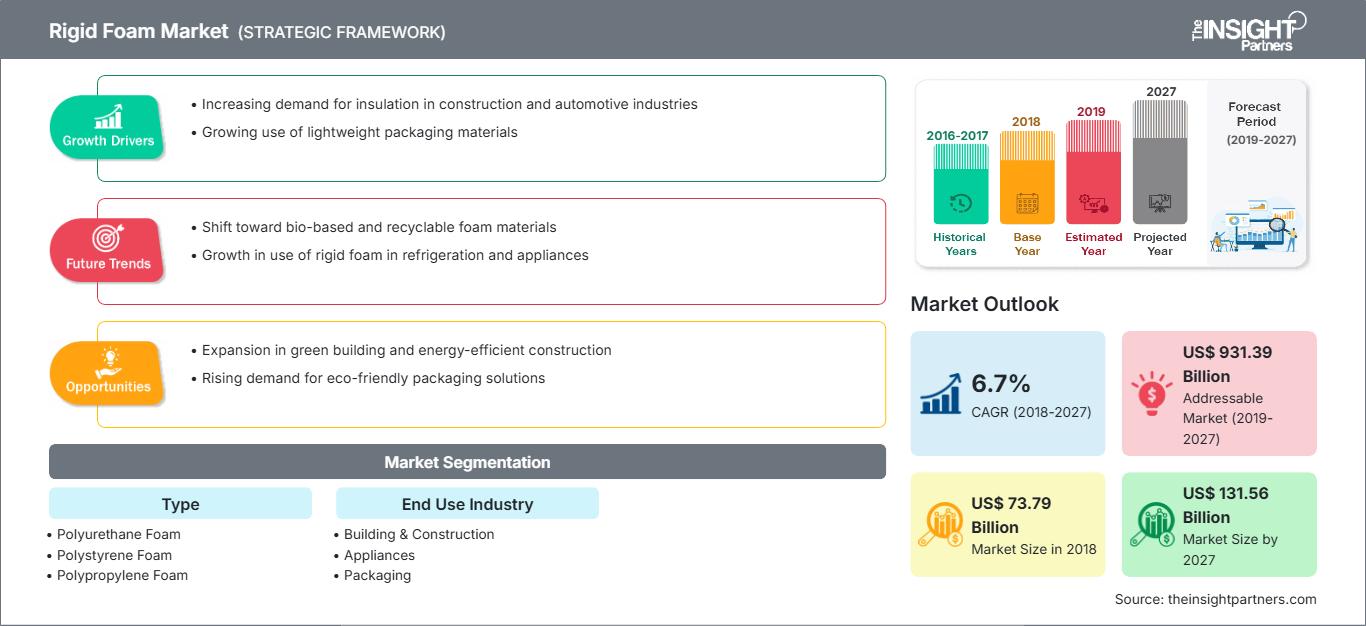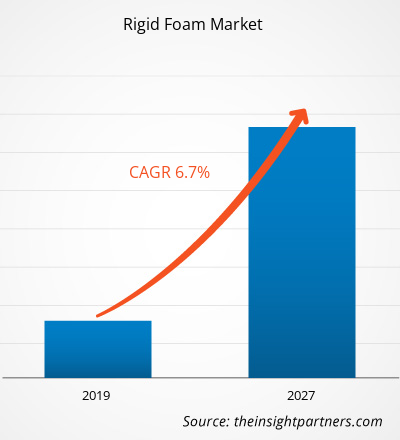[Forschungsbericht]Der Markt für Hartschaumstoffe belief sich im Jahr 2018 auf 73.786,7 Mio. US-Dollar und soll im Prognosezeitraum 2019–2027 mit einer durchschnittlichen jährlichen Wachstumsrate von 6,7 % wachsen und bis 2027 131.558,9 Mio. US-Dollar erreichen.
Hartschäume besitzen nachweislich verschiedene Eigenschaften wie Wasserdichtigkeit, Antistatik, Vibrationshemmung und Rutschfestigkeit, was sie zu einem idealen Material für den Einsatz in vielen Industriezweigen sowie im Baugewerbe macht. Hartschaumstoffe schützen die Betonoberflächen, auf die sie aufgetragen werden, und verlängern die Lebensdauer der darunter liegenden Betonböden. Sie sind unempfindlich gegenüber Ölen, Wasch- und Reinigungsmitteln, Getriebeflüssigkeiten, Wasser, Hagel, Schnee und ätzenden Chemikalien. Hartschaumstoffe werden auch verwendet, um die Ästhetik von Böden zu verbessern. Sie sind in verschiedenen Farben, Schattierungen und Texturen erhältlich. Metallische Pigmente und Vinylfarbflocken werden den Hartschaumsystemen zugesetzt, um Oberflächen mit schillernden Farben zu erzeugen. Die Ästhetik von buntem Hartschaum dürfte den Markt für Hartschaum ankurbeln und er wird zunehmend in Neubauprojekten und bei der Renovierung alter Häuser eingesetzt.
Im Jahr 2018 hatte die Region Asien-Pazifik den größten Anteil am globalen Hartschaummarkt. Dieses Marktwachstum in der Region ist hauptsächlich auf die Präsenz großer Hartschaumhersteller in der Region zurückzuführen. Auch die steigende Produktion von Hartschaum dürfte das Marktwachstum zwischen 2019 und 2027 ankurbeln. Im asiatisch-pazifischen Raum machte China gemessen am Umsatz den größten Anteil an Hartschaum aus.
Passen Sie diesen Bericht Ihren Anforderungen an
Sie erhalten kostenlos Anpassungen an jedem Bericht, einschließlich Teilen dieses Berichts oder einer Analyse auf Länderebene, eines Excel-Datenpakets sowie tolle Angebote und Rabatte für Start-ups und Universitäten.
Markt für Hartschaum: Strategische Einblicke

- Holen Sie sich die wichtigsten Markttrends aus diesem Bericht.Dieses KOSTENLOSE Beispiel umfasst Datenanalysen, die von Markttrends bis hin zu Schätzungen und Prognosen reichen.
Markteinblicke: Einführung neuer Poly(lactid-urethan-isocyanurat)-Schäume auf Basis von Bio-Polylactid-Abfällen
Sie erhalten kostenlos Anpassungen an jedem Bericht, einschließlich Teilen dieses Berichts oder einer Analyse auf Länderebene, eines Excel-Datenpakets sowie tolle Angebote und Rabatte für Start-ups und Universitäten.
Markt für Hartschaum: Strategische Einblicke

- Holen Sie sich die wichtigsten Markttrends aus diesem Bericht.Dieses KOSTENLOSE Beispiel umfasst Datenanalysen, die von Markttrends bis hin zu Schätzungen und Prognosen reichen.
In den letzten Jahren wurden rasante Fortschritte im Polymerbereich mit einer steigenden Produktion von Kunststoffen und Polymeren beobachtet. Der Aufwärtstrend in der Polymerindustrie dürfte zu einer hohen Produktion von Polymerabfällen führen. Darüber hinaus wurden im Zuge des Umweltschutzes neue Regeln und Vorschriften erlassen, die Wissenschaftler und Unternehmer dazu bewegen, nach alternativen Lösungen für die Handhabung und Behandlung von Kunststoffabfällen zu suchen oder biologisch abbaubare Kunststoffe einzusetzen, die sich in der Natur zersetzen. Unter den verschiedenen weltweit produzierten biologisch abbaubaren Kunststoffen gilt Polylactid (PLA) als eine der bevorzugten Biokunststoffe. Die Abfälle dieser Kunststoffe lassen sich problemlos zu vollwertigen Produkten wie Polyurethan-Polyisocyanurat-Hartschäumen (RPU/PIR) verarbeiten. Solche Schäume aus biologisch abbaubarem Polylactid gelten als nachhaltige Lösungen. Einer von Europe PMC vorgelegten Studie zufolge kann Polylactid petrochemisches Polyol bei der Formulierung von Polyisocyanurat teilweise ersetzen. Die erhaltenen PIR-Schäume weisen zudem verschiedene Eigenschaften auf, wie beispielsweise eine minimale Rohdichte, Sprödigkeit und Wasseraufnahmefähigkeit. Daher kann die Verwendung von aus Kunststoffabfällen hergestelltem PLA-Polyol eine hervorragende Alternative zu petrochemischen Polyolen sein. Solche Entwicklungen helfen, die knappen Ressourcen zu verwalten und Abfälle effektiv zu nutzen. Zudem gelten die aus solchen Biomaterialien hergestellten Produkte als umweltfreundliche Lösungen.
Typ-Einblicke
Basierend auf dem Typ ist der Markt für Hartschaumstoffe in Polyurethanschaum, Polystyrolschaum, Polypropylenschaum, Polyethylenschaum, Polyvinylchloridschaum und andere unterteilt. Das Segment Polyurethanschaum dominiert den globalen Markt für Hartschaumstoffe. Harter Polyurethanschaum wird aufgrund seiner hervorragenden Isoliereigenschaften und guten Dimensionsstabilität häufig in der Kühl-, Bau- und Verpackungsindustrie verwendet.
Einblicke in die Endverbraucherbranche
Der Markt für Hartschaumstoffe ist nach Endverbraucherbranchen in Bauwesen, Haushaltsgeräte, Verpackung, Automobilindustrie und andere unterteilt. Der Bausektor machte den größten Anteil am globalen Markt für Hartschaumstoffe aus. Ihr Einsatz beim Bau von Häusern und Gebäuden reduziert den Energiebedarf zum Heizen und Kühlen von Innenräumen von Gebäuden, Geschäften und Büros. Der steigende Verbrauch von Hartschaumstoffen im Bausektor dürfte das Wachstum des globalen Marktes für Hartschaumstoffe im Prognosezeitraum unterstützen.
Unternehmen verfolgen häufig verschiedene Strategien, um ihre weltweite Präsenz auszubauen. Huntsman Corporation, Covestro und BASF SE gehören zu den Hauptakteuren auf dem globalen Markt für Hartschaumstoffe, die diese Strategien umsetzen, um ihren Kundenstamm zu erweitern und bedeutende Marktanteile zu gewinnen, was ihnen wiederum ermöglicht, ihren Markennamen weltweit zu behaupten.
HartschaumRegionale Einblicke in den Hartschaummarkt
Die Analysten von The Insight Partners haben die regionalen Trends und Faktoren, die den Hartschaummarkt im Prognosezeitraum beeinflussen, ausführlich erläutert. In diesem Abschnitt werden auch die Marktsegmente und die geografische Lage in Nordamerika, Europa, dem asiatisch-pazifischen Raum, dem Nahen Osten und Afrika sowie Süd- und Mittelamerika erörtert.
Umfang des Marktberichts über Hartschaum
| Berichtsattribut | Einzelheiten |
|---|---|
| Marktgröße in 2018 | US$ 73.79 Billion |
| Marktgröße nach 2027 | US$ 131.56 Billion |
| Globale CAGR (2018 - 2027) | 6.7% |
| Historische Daten | 2016-2017 |
| Prognosezeitraum | 2019-2027 |
| Abgedeckte Segmente |
By Typ
|
| Abgedeckte Regionen und Länder | Nordamerika
|
| Marktführer und wichtige Unternehmensprofile |
|
Dichte der Marktteilnehmer für Hartschaum: Verständnis ihrer Auswirkungen auf die Geschäftsdynamik
Der Markt für Hartschaumstoffe wächst rasant. Die steigende Nachfrage der Endverbraucher ist auf Faktoren wie veränderte Verbraucherpräferenzen, technologische Fortschritte und ein stärkeres Bewusstsein für die Produktvorteile zurückzuführen. Mit der steigenden Nachfrage erweitern Unternehmen ihr Angebot, entwickeln Innovationen, um den Bedürfnissen der Verbraucher gerecht zu werden, und nutzen neue Trends, was das Marktwachstum weiter ankurbelt.

- Holen Sie sich die Markt für Hartschaum Übersicht der wichtigsten Akteure
- Fortschreitende Branchentrends im Hartschaummarkt helfen den Akteuren bei der Entwicklung effektiver langfristiger Strategien
- Geschäftswachstumsstrategien entwickelter und sich entwickelnder Märkte
- Quantitative Analyse des Hartschaummarktes von 2017 bis 2027
- Schätzung der Nachfrage nach Hartschaum in verschiedenen Branchen
- PEST-Analyse zur Veranschaulichung der Wirksamkeit von in der Branche tätigen Käufern und Lieferanten bei der Vorhersage des Marktwachstums
- Jüngste Entwicklungen zum Verständnis des Wettbewerbsmarktszenarios und der Nachfrage nach Hartschaum
- Markttrends und -aussichten in Verbindung mit Faktoren, die das Wachstum des Hartschaummarktes vorantreiben und hemmen
- Verständnis der Strategien, die das kommerzielle Interesse im Hinblick auf das Wachstum des Hartschaummarktes untermauern, was den Entscheidungsprozess für die Größe des Hartschaummarktes der Beteiligten an verschiedenen Marktknotenpunkten erleichtert
- Detaillierter Überblick und Segmentierung des Hartschaummarktes sowie seiner Dynamik in der Branche
Globaler Hartschaummarkt – nach Typ
- Polyurethanschaum
- Polystyrolschaum
- Polypropylenschaum
- Polyethylenschaum
- Polyvinylchloridschaum
- Sonstige
Globaler Markt für Hartschaum – nach Endverbrauchsbranche
- Bau & Bauwesen
- Haushaltsgeräte
- Verpackung
- Automobil
- Sonstige
Unternehmensprofile
- Saint-Gobain
- Dow Chemical Corporation
- BASF SE
- Borealis AG
- Sekisui Chemical Co.,Ltd
- Covestro AG
- Armacell International SA
- Huntsman International LLC
- JSP
- Zotefoams Plc
- Historische Analyse (2 Jahre), Basisjahr, Prognose (7 Jahre) mit CAGR
- PEST- und SWOT-Analyse
- Marktgröße Wert/Volumen – Global, Regional, Land
- Branchen- und Wettbewerbslandschaft
- Excel-Datensatz
Aktuelle Berichte
Erfahrungsberichte
Grund zum Kauf
- Fundierte Entscheidungsfindung
- Marktdynamik verstehen
- Wettbewerbsanalyse
- Kundeneinblicke
- Marktprognosen
- Risikominimierung
- Strategische Planung
- Investitionsbegründung
- Identifizierung neuer Märkte
- Verbesserung von Marketingstrategien
- Steigerung der Betriebseffizienz
- Anpassung an regulatorische Trends




















 Kostenlose Probe anfordern für - Markt für Hartschaum
Kostenlose Probe anfordern für - Markt für Hartschaum